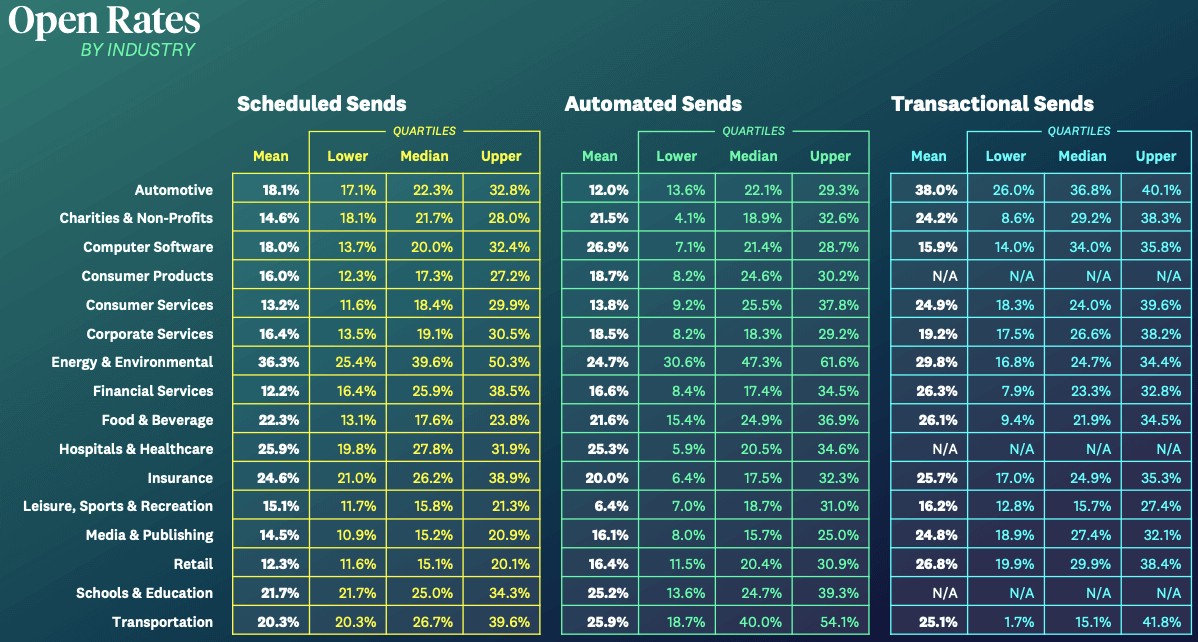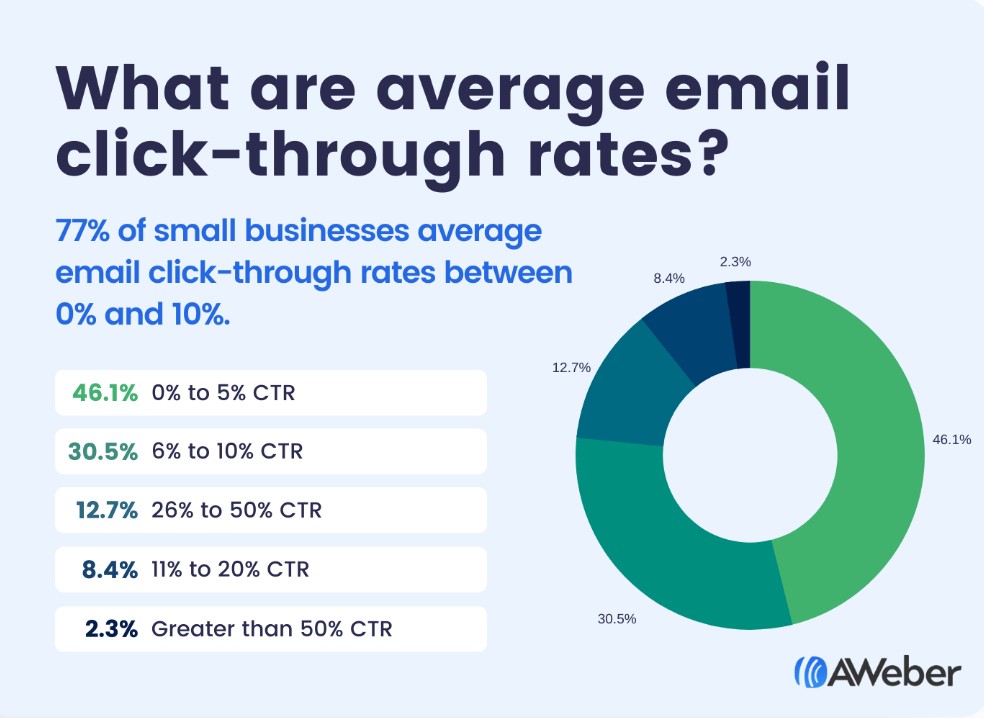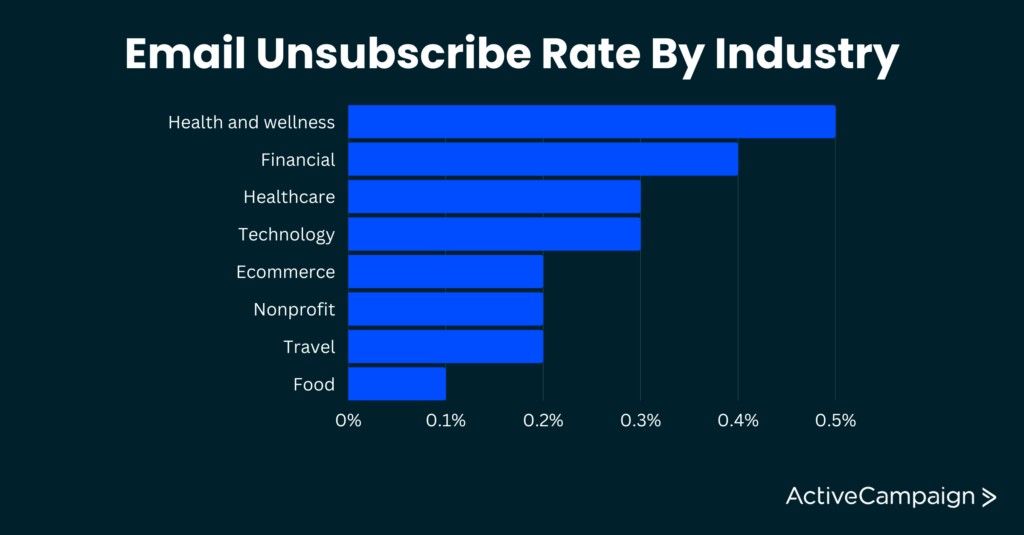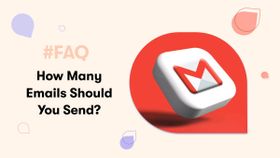The Top 5 Email Marketing KPIs to Track in 2026
Want to measure the success of your email marketing campaigns? Don't miss these top key performance indicators, tips on how to calculate them, and more.
Updated November 6, 2024

Every second, thousands of emails are sent, creating digital chatter like the rustle of a million leaves. 373 billion, to be exact, given that's the number of emails nearly 5 billion people send daily.
There's gold beyond the noise. If you want to make the most out of your email marketing efforts (and make $36 for every $1 you spend), you need to watch your email marketing KPIs.
How to do it?
Here is a guide on the essentials of key performance indicators that all email marketers agree on:
Unveiling the power of email open rate
Your email open rate is the percentage of recipients who open your marketing emails. It's one of the most important email marketing metrics to measure because it shows how effective your subject line is in enticing people to view your message.
You should see this KPI as a valuable performance metric that gives a glimpse into the effectiveness of your email marketing strategy. Your open rate essentially measures the first vital interaction between your brand and the recipient. Any email marketing tool worth the money will make this and all email metrics clear and easy to find.
A high email open rate implies your email subject lines are compelling and relevant to your audience and/or your brand is strong enough to compel people to click the subject line.
Conversely, a low email open rate signals that something might be off. It could be that your
- emails are ending up in spam folders,
- subject lines are not catchy enough to spur intrigue, or your
- contact list has an outdated email address or two that needs to be weeded out.
Understanding this key performance indicator ultimately helps you make data-driven decisions to yield better email marketing outcomes.
How to calculate the email open rate
To find your email open rate, divide the number of opened emails by the total number of emails sent, subtracting any bounces. Then, multiply by 100 to get the percentage. Here is a simple formula:
(Number of emails opened ÷ (Total emails sent - Emails Bounced)) × 100 = Email Open Rate
This calculation allows you to accurately track and gauge the efficiency of your email marketing efforts. It's simple arithmetic but has powerful implications for your overall digital marketing success.
Strategies to improve your email open rate
Increasing your email open rate is like a strategic game of chess. Each move must be thought out, calculated, and executed with intent. Successful tactics include:
- Craft compelling subject lines: Your subject line is the first impression. Make it engaging, relevant, and benefit-driven to entice opens.
- Maintain a clean email list: Regularly remove inactive subscribers or invalid email addresses. This ensures false signals don't dilute your open rate, and keeps a low email bounce rate, as well.
- Optimize send times: Monitor when your emails get the best open rate and adjust your delivery times accordingly. A well-timed email can boost click-to-open rates significantly.
- Personalize your emails: Customizing email content to the individual subscriber increases relevance, which in turn drives opens.
These strategies are not one-size-fits-all. It's crucial to continually test, monitor, and adjust your approach based on your unique audience, business objectives, and industry benchmarks.
(Source)
Email open rate not as high as you'd like?
Remember: it’s a dynamic metric, always subject to change. You now hold the keys to nudge your numbers in the right direction. Knowing this is the first step towards mastering email marketing campaigns. Whether it's a special occasion email (like a BFCM email campaign or a Father's Day campaign), a heads up about a new blog post, or a welcome email series, keeping an eye on your open rates will teach you more about
- The types of emails your customers like and don't like in their mail box
- The kind of Tone of Voice best-suited for your brand and audience
- How to create the most compelling subject lines and preheader/preview texts.
Your click-through rate (CTR): the key to engagement
If your open rate is a greeting, the click-through rate is an email KPI that shows you what makes people tick (or click, in this case).
An email CTR is the percentage of email recipients who clicked on one or more links within your email. This can be a social share or a link to your website, depending on your campaign goals. It's a powerful metric that tracks receiver engagement and highlights their interest in your content. A high CTR means more of your target audience is interacting with your message, taking you closer to your conversion goals.
However, the significance of CTR goes far beyond the raw numbers. The CTR is also a reflection of relevance and quality. If your subscribers consistently click and interact with your emails, it shows they find your content valuable. This compelling engagement builds a stronger sender-receiver relationship and is essential to any successful email marketing strategy.
How to measure your CTR effectively
The formula for finding the click-through rate is simple: divide the total number of clicks (i.e. people who clicked a link within the email) by the total delivered emails, then multiply by 100 for the percentage.
But calculating your CTR isn't enough. Try to understand what the numbers are telling you so that you can better prepare for future email campaigns. Interpret the metrics in the context of your marketing efforts and track the trends over time. Preferences, behaviors, and interests change, and evolving with these shifts is equally important.
You might also want to compare your CTR with industry standards to see where you stand. If your click-through rate stands below average, re-evaluating your email strategy is a strong call. If you're above the standard, you've got the start of a successful campaign. Keep doing what you're doing!
Proven methods to boost your CTR
Even if you have a great CTR, there's always room for improvement. A higher CTR is an opportunity for more engaged subscribers, more sales, and, eventually, a bigger bottom line. Here are a few proven strategies:
Improve email relevance
Segment your email list to ensure you're sending the right types of content to the right audience. Relevant content appeals to your subscriber's interests or needs, raising the chance they'll click through.
Creating compelling content
Experiment with different types of content to see what resonates with your audience. Use enticing headlines, relevant images, and clear calls to action. Include social share links if that's aligned with your email marketing KPIs.
A/B testing
Test different aspects of your email to for better informed decisions on what works best for your audience. Version A could test one headline for a percentage of email recipients, and version B tests another. The data will show which one performs better.
(Source)
Psst: already too much on your plate to deal with your click-to-open rate, unengaged subscribers, and other essential email marketing KPIs? Contact Mayple, and we'll match you with a vetted email marketing expert in under 72 hours!
Conversion rate: turning readers into customers
Opens and clicks are nice, but they don't pay the bills. To make sure you're reaping all the benefits of email marketing, you must follow your conversion rate as well.
Remember: your conversion rate is the percentage of recipients who take the desired action—be it purchasing your product, signing up for a webinar, or downloading a resource—after receiving your email. This number solidifies the effectiveness of your call-to-action and the overall relevancy of your content. By optimizing your Conversion Rate, you're boosting your ROI and making the most out of your email marketing efforts.
How to calculate your conversion rate
Calculating your Conversion Rate is straightforward: divide the number of conversions by the total number of successful email deliveries, then multiply by 100 to get the percentage.
This simple formula provides a measurable metric that captures your email performance in persuading the reader to take action. However, note that what qualifies as a 'conversion' differs depending on your business goals. You get to define what action you want your readers to take when they read your email messages: be it a PDF download or another piece of content, a sign-up for a free trial, or an actual paid purchase.
Tips to enhance your email conversion rate
Wondering how to improve your Conversion Rate? Start by understanding your audience. Personalized emails to people tend to have higher conversion rates because they connect more closely with the recipient’s interests and needs. It also lowers the chances of your email looking like spam.
Secondly, create compelling calls to action (CTAs). A well-placed, well-worded CTA can make all the difference. It also makes for a clearer email communication strategy.
Thirdly, make your emails mobile-friendly. Most of your subscriber list will open emails on mobile devices, so ensure that each individual email looks good on a smaller screen. Lastly, don't overlook the power of testing. A/B tests can give you insights into what works best for your audience and set your marketing goals accordingly.
Focusing on conversion rate offers a sharp, clear lens to evaluate the output of your email marketing strategy. Is it driving the results you want? If not, adjusting the above-mentioned elements can help pave the path toward better KPIs for email marketing outcomes.
(Source)
The bounce rate: The silent killer of email marketing success
If your conversion, click-through, and open rates look all good, but you're still not getting the traction you aimed for, you should look into your hard and soft bounce rate. These are some of the most important stats that your email service provider can give you.
This metric measures the percentage of sent emails that could not be delivered to the recipient's mailbox. Low delivery rates signal a misfire in your email marketing strategy, leading to lost opportunities for engagement. You need to understand the two kinds of bounces to appreciate this problem fully.
The hard bounce: This is the 'Return to Sender' of the email world, meaning the email is permanently undeliverable. Reasons for this can be as simple as a typo in the email address or as critical as an email server blacklisting your domain.
The soft bounce: These are temporary delivery issues, primarily due to the recipient's mailbox being full, the server being down, or the email being too large. It's worth looking into whether your soft bounce rate is a result of an email client or content-related issue, which you have control over.
Understanding these two types of bounces is the first step in controlling how your email content reaches your contacts' inboxes, and to getting back on track to benefitting from the immense success of email marketing.
The impact of bounce rate on your email marketing campaign
A high bounce rate kills an email marketing campaign. It's like organizing an event, gathering people in one place, and then not showing up as the host.
Not meeting your audience means missed opportunities for conversions, which reduces your email marketing effectiveness. More so, a high bounce rate ruins your sender reputation, which is the email equivalent of your credit score. The lower your delivery rates, the worse your reputation, and the stricter Internet Service Providers (ISPs) are with your emails. This leads to more bounces, further harming your email deliverability.
In essence, if your email doesn’t reach the intended recipient, all the hard work you invested in crafting the perfect message, attractive design, irresistible call to action, and the right email frequency will go to waste.
(Source)
Ways to reduce your bounce rate and improve email deliverability
A high hard or soft bounce rate isn't the end of the world. This crucial email marketing metric needs to be addressed, sure, but there are ways to do it:
- Validate email addresses before you add them to your list. Employing an email validation tool automates this process and is highly recommended.
- Implement the double opt-in method. This strategy requires new email subscribers to take another step, confirming that they want to be on your list.
- Regularly clean up your email subscriber list. Pave the way for genuine engagement by removing inactive users hurting your bounce rate and sender reputation. Include an email unsubscribe option, as well.
The email unsubscribe rate: keeping your audience engaged
The unsubscribe rate is a numerical measure that quantifies the percentage of your email list that opts out of your email communications over a given time period. A rising unsubscribe rate is a call to action, suggesting a need to reassess your email content, frequency, or overall email marketing strategy. Meanwhile, a rising list growth rate means you're on the right track.
Think of it this way: if you sell tickets to a show and people start falling asleep, something's wrong. The snacks they all had before the show might have been too heavy or your show is just not that great.
When a potential customer opts out of your subscriber list, this is a clear message that your communication process is no longer effective or relevant to them. Therefore, keeping a vigilant eye on your Unsubscribe Rate is paramount in ensuring your audience stays engaged and your content remains valuable. It's also a proactive way of curbing your spam complaint rates.
Calculating your unsubscribe rate
The formula to calculate the unsubscribe rate is simple: divide the number of email list unsubscribers in a given time by the total number of emails delivered during that same time. Then, multiply the result by 100 to get the percentage. Keeping track of these figures monthly can give you a clear picture of your audience's behavior and interests. Remember, each unsubscriber is a potential customer lost.
(Source)
How to lower your unsubscribe rate
Seeing people unsubscribe from the email list you built with so much hard work can be disheartening. Yes, those farewell notes from subscribers catch us off guard. You could be an email marketer with decades of experience and still take them like a knife to the heart.
Here are some tactics to help you with this:
Improve email quality
Great content is irresistible! Ensure your future email campaigns provide value to your subscribers in the form of practical information, exciting deals, or beneficial resources. Subscribers stick with content that proves worthwhile.
Focus on relevance
Are your emails reaching the right people? By segmenting your list, emails can be tailor-made to suit the recipient's interest. When a larger percentage of people get what they want, your Unsubscribe Rate diminishes.
Respect the frequency
Nothing frustrates a subscriber more than a cluttered inbox. Choose the frequency of your emails judiciously, and don't bombard your audience with redundant communications - less is sometimes more.
You can also offset this email marketing KPI with campaigns that focus on improving your list growth rate. Whether it's through social media posts or encouraging email sharing in your email content.
The real deal is to keep it simple, engaging, and subscriber-centric. Successfully managing your unsubscribe rate boosts your email marketing effectiveness and enhances your relationship with the audience. All you need is careful attention, clever strategy, and consistency.
Harmonizing all of your KPIs for email marketing
Understanding email marketing KPIs is not just about looking at them in isolation. Each KPI tells you a portion of your campaign's story, and syncing them gives you a complete picture.
Say you notice high open rates but low conversion rates. What might this indicate? Your subject lines are probably compelling enough, but the content never actually delivers what's promised. Such analysis is only possible if you combine insights from different KPIs.
By identifying patterns and correlations between KPIs, you can understand your campaign's strengths and weaknesses, enabling you to make more strategic and informed decisions for future campaigns.
It's essential to keep an eye on all KPIs, maintaining a balance and achieving a harmonious interplay. Resist the temptation to focus on a star KPI, like open rates. Remember that KPIs are interconnected. A higher open rate or list growth rate doesn't always mean success. Without other equally well-performing KPIs such as high click-through rates and low bounce rates, your campaign might face challenges.
Using the right email marketing platform for your needs can also make a tremendous difference in measuring your email marketing performance.
Need someone to handle your email campaign metrics for you? Contact Mayple, and we'll match you with a vetted email marketing expert in under 72 hours!









